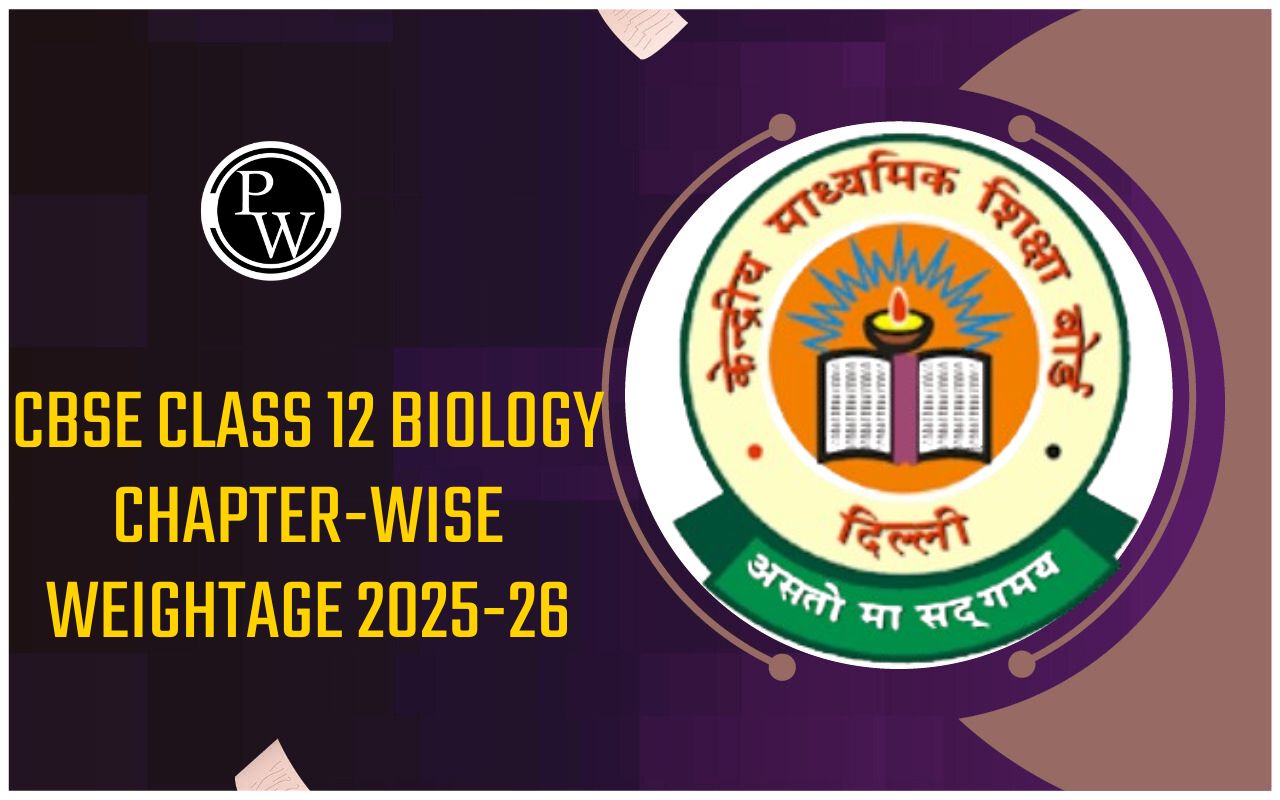
NCERT Solutions for Class 12 Biology Chapter 11: NCERT Solutions for Class 12 Biology Chapter 11 Organisms and Populations provide a comprehensive understanding of ecological concepts like the interaction between organisms and their environments.
By solving the NCERT questions, students gain clarity on key ideas such as the factors affecting population growth, the concept of biotic and abiotic components, and the types of population interactions. These solutions help students develop problem-solving skills reinforce theoretical knowledge, and prepare for their exams with confidence. They provide a structured approach to revising important concepts ensuring students are well-prepared for both board exams and competitive tests.NCERT Solutions for Class 12 Biology Chapter 11 Overview
Chapter 11 of Class 12 Biology Organisms and Populations focuses on understanding the interaction between living organisms and their environment. It covers the basic principles of ecology, including the relationship between organisms and their physical surroundings (abiotic factors) as well as the other living organisms (biotic factors). The chapter also discusses various types of ecosystems, such as terrestrial and aquatic ecosystems, and how organisms adapt to survive in specific conditions. Population interactions, such as predation, competition, and mutualism, are explored to help students understand the dynamics within an ecosystem. By solving the NCERT solutions, students can strengthen their understanding of complex ecological concepts, which are essential for both exams and real-world applications of biology.NCERT Solutions for Class 12 Biology Chapter 11 PDF
For easy access, you can find the NCERT Solutions for Class 12 Biology Chapter 11 Organisms and Populations PDF link below. Simply click on the link to download or view the solutions:NCERT Solutions for Class 12 Biology Chapter 11 PDF
1. How is diapause different from hibernation?
Solution:
Diapause is a phase of suspended development to deal with unfavorable conditions, commonly observed in species like zooplankton and insects, allowing them to survive extreme climatic conditions during development. Hibernation, also known as winter sleep, is a resting phase where animals reduce their metabolic rate to survive cold temperatures by entering a state of inactivity. This is typically observed in animals like squirrels, bats, and certain rodents.2. If a marine fish is placed in a freshwater aquarium, will the fish be able to survive? Why or why not?
Solution:
A marine fish would struggle to survive in a freshwater aquarium because it is adapted to a high-salt environment. In freshwater, the surrounding environment is hypotonic (lower salt concentration), causing water to flow into the fish's body through osmosis. The fish cannot regulate this influx of water, leading to swelling and ultimately death due to osmotic imbalance.3. Most living organisms cannot survive at temperatures above 45°C. How are some microbes able to live in habitats with temperatures exceeding 100°C?
Solution:
Thermophiles, a type of archaebacteria, can survive in extreme environments such as deep-sea hydrothermal vents and hot springs, where temperatures exceed 100°C. These organisms have adapted to such high temperatures by evolving heat-resistant enzymes that continue to function without denaturing, allowing them to thrive in such extreme conditions.4. List the attributes that populations possess but not individuals.
Solution:
Populations, which consist of multiple individuals of the same species in a specific area, exhibit the following attributes:- Natality (Birth rate): The number of live births in a population within a certain period.
- Mortality (Death rate): The number of deaths in a population during a specific period.
- Age distribution: The proportion of individuals in various age groups within a population.
- Sex ratio: The ratio of males to females in a population.
- Population density: The number of individuals per unit area or volume.
5. If a population grows exponentially and doubles in size in 3 years, what is the intrinsic rate of increase (r) of the population?
Solution:
If an adequate quantity of food resources is available to individuals in a population, it grows exponentially. The integral form of the exponential growth equation can be used to estimate the exponential growth, which is as follows: N t = N o e rt ————– equation (1) Where N t is the population density after ‘t’ time. N o is the population density at time zero. e is the base of natural logarithm = 2.71828 r is the intrinsic rate of natural increase. Let the current population density be ‘x’. ∴ The population density after two years will be 2x, and the t given is 3 years. Substituting these values in equation (1),
6. Name important defense mechanisms in plants against herbivory.
Solution:
Plants defend themselves against herbivores using both chemical and morphological mechanisms:Chemical defenses:
- Caffeine, nicotine, opium, and quinine are substances produced by plants to deter herbivores.
- Calotropis produces lethal cardiac glycosides that can be toxic to herbivores.
Morphological defenses:
- Cactus plants have spiny leaves to deter herbivores.
- Acacia plants have sharp thorns to prevent feeding.
- Some plants, like Opuntia, have modified leaves that serve as spines.
7. An orchid plant is growing on the branch of a mango tree. How do you describe this interaction between the orchid and the mango tree?
Solution:
The interaction between the orchid plant and the mango tree is an example of commensalism. In this type of relationship, one organism benefits while the other is neither helped nor harmed. The orchid, which is an epiphyte, grows on the branch of the mango tree. Epiphytes, like orchids, do not take nutrients from the host plant; instead, they derive moisture and nutrients from the air, water, and rain. In this case, the orchid benefits from the physical support provided by the mango tree, allowing it to grow and access more sunlight. However, the mango tree is not affected by the presence of the orchid, as it does not lose any nutrients or energy in the process. Therefore, the interaction is beneficial for the orchid but neutral for the mango tree.8. What is the ecological principle behind the biological control method of managing pest insects?
Solution:
The ecological principle behind biological control is predation , where a predator controls the population of pest insects by feeding on them. For example, the introduction of fish like Gambusia to water bodies helps reduce mosquito larvae populations.9. Distinguish between the following:
(a) Hibernation and Aestivation
(b) Ectotherms and Endotherms
Solution:
(a) Hibernation and Aestivation
| Hibernation | Aestivation |
|---|---|
| Also known as winter sleep, it is a state of reduced activity observed in some organisms to escape extremely cold climatic conditions. | Also known as summer sleep, it is a state of reduced activity observed in some organisms to avoid dehydration caused by excessive heat in summer. |
| Examples: Squirrels and bears in cold regions hibernate during winter. | Examples: Snails and fishes aestivate during hot summer months. |
(b) Ectotherms and Endotherms
| Ectotherms | Endotherms |
|---|---|
| The body temperature varies with the surroundings. | The body temperature remains constant, regardless of the surrounding temperature. |
| They are cold-blooded organisms. | They are warm-blooded organisms. |
| Examples: Reptiles, fishes, and amphibians. | Examples: Mammals and birds. |
10. Write a short note on
(a) Adaptations of desert plants and animals
(b) Adaptations of plants to water scarcity
(c) Behavioral adaptations in animals
(d) Importance of light to plants
(e) Effect of temperature or water scarcity and the adaptations of animals.
Solution:
(a) Adaptations of desert plants and animals
- Desert Plants: Adaptations include deep root systems, sunken stomata, and thick cuticles to minimize water loss. Some plants, like Opuntia, have spines instead of leaves, and their green stems carry out photosynthesis.
- Desert Animals: Animals like kangaroo rats can concentrate urine to conserve water, while desert lizards regulate their body temperature by basking in the sun in the morning and burrowing to escape heat during the day.
(b) Adaptations of plants to water scarcity
Plants in arid conditions develop features like deep roots, sunken stomata, and thick cuticles to reduce transpiration and efficiently use limited water.(c) Behavioral adaptations in animals
Animals adapt behaviorally through migration, hibernation, or aestivation. Cold-blooded animals like reptiles adjust their activity patterns to control their temperature, while warm-blooded animals hibernate or aestivate to escape extreme temperatures.(d) Importance of light to plants
Light is crucial for photosynthesis, which is the process by which plants convert light into energy. Plants also rely on light for photoperiodic responses that regulate flowering.(e) Effect of temperature or water scarcity and the adaptations of animals
Temperature and water availability significantly affect animal distribution. Animals in cold climates have thick fur and fat to conserve heat, while desert animals like kangaroo rats conserve water by not drinking and adapting to extreme heat.11. List the various abiotic environmental factors.
Solution:
Abiotic Environmental Factors
Abiotic environmental factors are the non-living components that affect an ecosystem. These factors include:Temperature
Temperature plays a crucial role in the distribution of organisms. It varies seasonally and decreases from the equator to the poles and from plains to mountain tops. Temperature can range from sub-zero in polar regions to over 50°C in tropical deserts during summer. Some extreme habitats like deep-sea hydrothermal vents can have temperatures exceeding 100°C. Organisms that can tolerate a wide range of temperatures are known as eurythermal (e.g., birds and mammals), while those that can only tolerate a narrow temperature range are stenothermal (e.g., polar bears).Water
Water is essential for life. It supports marine life, and factors such as pH, water temperature, and chemical composition are significant for aquatic organisms. Water salinity also plays a role—freshwater has low salinity (less than 5 parts per thousand), while seawater has higher salinity (30-35 parts per thousand). Euryhaline organisms can tolerate a wide range of salinity, while stenohaline organisms can only survive in a narrow salinity range. Freshwater animals usually cannot survive in seawater due to osmotic issues.Soil
The soil's characteristics vary depending on climate, weathering processes, and soil development. Key factors such as grain size, aggregation, and composition influence the soil’s water-holding capacity and drainage. Soil properties like pH, mineral content, and topography also determine the types of plants that can thrive in a particular habitat.Light
Light is essential for photosynthesis in autotrophs, which release oxygen during the process. Some plants, such as those in forests, adapt to low light intensities due to shading by tall trees. Light also affects the timing of reproduction, migration, and feeding activities in animals. Light availability is linked to temperature, as sunlight is the primary energy source. In deep oceans, where light does not penetrate, organisms have adapted to the lack of sunlight. The UV component of light can be harmful to many organisms. Different algae types occur at various ocean depths depending on the available light spectrum.12. Give an example for:
(a) An endothermic animal
(b) An ectothermic animal
(c) An organism of benthic zone
Solution:
(a) An endothermic animal – Crows, sparrows, cranes, cows, rabbits, rats, etc. (b) An ectothermic animal – Fish such as amphibians, sharks, frogs, snakes, tortoises, lizards, etc. (c) An organism of the benthic zone – Decomposing bacteria is an organism of the benthic zone.13. Define population and community.
Solution:
Population – It can be defined as a group of individuals of the same species inhabiting a particular geographical area at a given time, functioning as a unit. Community – It can be defined as a group of individuals of various species living in a certain geographical region. These individuals can be dissimilar or similar but cannot reproduce with members of other species.14. Define the following terms and give one example for each:
(a) Commensalism
(b) Parasitism
(c) Camouflage
(d) Mutualism
(e) Interspecific competition
Solution:
(a) Commensalism Commensalism is an interaction between two species in which one species benefits, while the other is neither helped nor harmed.Example: Barnacles attached to a whale's body, where the barnacles benefit by getting access to nutrient-rich waters while the whale is unaffected.
(b) Parasitism Parasitism is a relationship between two species where one benefits (the parasite) and the other is harmed (the host). The parasite derives nutrients from the host, often weakening it.Example: A liver fluke living inside the body of a host, deriving nutrition from the host, which becomes weak as a result.
(c) Camouflage Camouflage is a defense mechanism where an organism uses color or patterns to blend in with its environment, helping it avoid predators.Example: Frogs with green coloring blending into the leaves to escape predators.
(d) Mutualism Mutualism is an interaction where both species involved benefit from the relationship.Example: Lichens, where fungi and blue-green algae live together. The fungi provide a structure for the algae, and the algae provide nutrients through photosynthesis.
(e) Interspecific competition Interspecific competition occurs when individuals of different species compete for the same resources, such as food, space, or light, and both are negatively affected.Example: The competition between flamingos and fish in South American lakes for zooplankton as food.
15. With the help of a suitable diagram, describe the logistic population growth curve.
Solution:
The logistic population growth curve is usually observed in yeast cells cultivated in laboratory conditions and includes five phases, namely:- The lag phase – The population of a yeast cell is small initially as resources are limited in the habitat.
- Exponential phase – In this stage, the population of the yeast cell suddenly rises as a result of rapid growth leading to exponential population growth due to the availability of enough food resources and consistently favourable environmental conditions without any interspecific competition. This results in the curve rising upwards steeply.
- Positive acceleration phase – At the start of this phase, cell growth is limited. The yeast cell adjusts to the new environment and grows its population.
- Negative acceleration phase – The environmental resistance increases, and the growth rate of the population decline as a result of increased competition between the yeast cells for shelter and food.
- Stationary phase – The population is stable in this phase. The count of cells generated in a population is equivalent to the number of cells that die out. Additionally, the species’ population is said to have touched nature’s carrying capacity in its habitat. The S-shaped growth curve is also referred to as the Verhulst-pearl logistic curve.

16. Select the statement which explains best parasitism.
(a) One organism is benefited.
(b) Both the organisms are benefited.
(c) One organism is benefited, other is not affected.
(d) One organism is benefited, and another is affected.
Solution:
(d) One organism is benefited, and another is affected. Parasitism is a type of interaction between two species wherein one species (parasite) gets benefits while the other species or the host is negatively affected/harmed. Example: Lice or ticks (parasites) found on the human body (host) is an example, wherein lice derive their nutrition by feeding on the humans’ blood, causing the fitness of the individual (host) to reduce, harming the human body.17. List any three important characteristics of a population and explain.
Solution:
A group of entities belonging to the same species, residing in a specific geographical area at a particular time, together functioning as a unit can be termed a population. Example: All humans living in a particular area at a specific time comprise the population of humans. Listed below are the attributes that a population exhibits:- Natality or Birth rate
- Mortality or Death rate
- Age distribution
Benefits of Solving NCERT Solutions for Class 12 Biology Chapter 11
Clarifies Important Ideas: This chapter talks about topics like how organisms live together, how populations grow, and how they interact. Solving the questions helps students understand these ideas better.
Strengthens Knowledge: The chapter covers ecological relationships and how organisms are spread out. By solving the questions, students get a better understanding of these topics, which are important in biology.
Helps in Revision: NCERT Solutions provide a clear way to review the chapter. It makes sure students learn everything important and are ready for exams.
Shows Real-World Uses: The chapter connects science to real life, showing how organisms and their environment work together. Solving questions helps students see how the concepts are used in the world around them.
Builds a Strong Base: Understanding this chapter is important for studying more difficult topics in biology later. Solving these questions helps students build a strong foundation.
Helps Remember Better: By solving questions, students practice and remember the ideas better. This makes it easier to recall information during exams.
NCERT Solutions for Class 12 Biology Chapter 11 FAQs
What is carrying capacity?
What is population density?
What is exponential growth in a population?
What is logistic growth?










